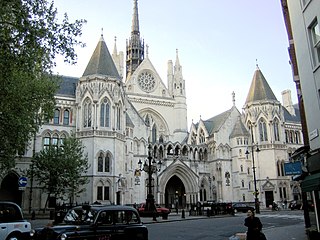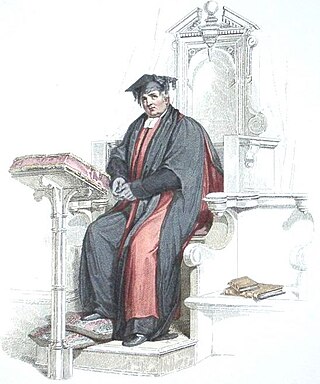
In law, common law is the body of law created by judges and similar quasi-judicial tribunals by virtue of being stated in written opinions.

Sir Thomas More PC, venerated in the Catholic Church as Saint Thomas More, was an English lawyer, judge, social philosopher, author, statesman, and noted Renaissance humanist. He also served Henry VIII as Lord High Chancellor of England from October 1529 to May 1532. He wrote Utopia, published in 1516, which describes the political system of an imaginary island state.

In the field of jurisprudence, equity is the particular body of law, developed in the English Court of Chancery, with the general purpose of providing legal remedies for cases wherein the common law is inflexible and cannot fairly resolve the disputed legal matter. Conceptually, equity was part of the historical origins of the system of common law of England, yet is a field of law separate from common law, because equity has its own unique rules and principles, and was administered by courts of equity.

English law is the common law legal system of England and Wales, comprising mainly criminal law and civil law, each branch having its own courts and procedures.

The Court of Chancery was a court of equity in England and Wales that followed a set of loose rules to avoid a slow pace of change and possible harshness of the common law. The Chancery had jurisdiction over all matters of equity, including trusts, land law, the estates of lunatics and the guardianship of infants.

Sir William Blackstone was an English jurist, justice and Tory politician most noted for his Commentaries on the Laws of England, which became the best-known description of the doctrines of the English common law. Born into a middle-class family in London, Blackstone was educated at Charterhouse School before matriculating at Pembroke College, Oxford, in 1738. After switching to and completing a Bachelor of Civil Law degree, he was made a fellow of All Souls College, Oxford, on 2 November 1743, admitted to Middle Temple, and called to the Bar there in 1746. Following a slow start to his career as a barrister, Blackstone became heavily involved in university administration, becoming accountant, treasurer and bursar on 28 November 1746 and Senior Bursar in 1750. Blackstone is considered responsible for completing the Codrington Library and Warton Building, and simplifying the complex accounting system used by the college. On 3 July 1753 he formally gave up his practice as a barrister and instead embarked on a series of lectures on English law, the first of their kind. These were massively successful, earning him a total of £453, and led to the publication of An Analysis of the Laws of England in 1756, which repeatedly sold out and was used to preface his later works.

The Commentaries on the Laws of England are an influential 18th-century treatise on the common law of England by Sir William Blackstone, originally published by the Clarendon Press at Oxford between 1765 and 1769. The work is divided into four volumes, on the rights of persons, the rights of things, of private wrongs and of public wrongs.

A Doctor of Divinity is the holder of an advanced academic degree in divinity.

In the history of the courts of England and Wales, the Judicature Acts were a series of Acts of Parliament, beginning in the 1870s, which aimed to fuse the hitherto split system of courts of England and Wales. The first two Acts were the Supreme Court of Judicature Act 1873 and the Supreme Court of Judicature Act 1875, with a further series of amending acts.

A court of equity, also known as an equity court or chancery court, is a court authorized to apply principles of equity rather than principles of law to cases brought before it. These courts originated from petitions to the Lord Chancellor of England and primarily heard claims for relief other than damages, such as specific performance and extraordinary writs. Over time, most equity courts merged with courts of law, and the adoption of various Acts granted courts combined jurisdiction to administer common law and equity concurrently. Courts of equity are now recognized for complementing the common law by addressing its shortcomings and promoting justice.
The Court of Requests was a minor equity court in England and Wales. It was instituted by King Richard III in his 1484 parliament. It first became a formal tribunal with some Privy Council elements under Henry VII, hearing cases from the poor and from servants of the King. It quickly became popular for its low cost of bringing a case and rapid processing time, earning the disapproval of the common law judges. Two formal judges, the "Masters of Requests Ordinary", were appointed towards the end of Henry VIII's reign, with an additional two "Masters of Requests Extraordinary" appointed under Elizabeth I to allow two judges to accompany her on her travels around England. Two more ordinary masters were appointed under James I of England, with the increasing volume of cases bringing a wave of complaints as the court's business and backlog grew.
Sources of law are the origins of laws, the binding rules that enable any state to govern its territory.
Nominate reports, also known as nominative reports, named reports and private reports, is a legal term from common-law jurisdictions referring to the various published collections of reports of English cases in various courts from the Middle Ages to the 1860s, when law reporting was officially taken over by the Incorporated Council of Law Reporting, for example Edmund F. Moore's Reports of Cases Heard and Determined by the Judicial Committee and the Lords of His Majesty's most Honourable Privy Council on Appeal from the Supreme and Sudder Dewanny Courts in the East Indies published in London from 1837 to 1873, referred to as Moore's Indian Appeals and cited for example as: Moofti Mohummud Ubdoollah v. Baboo Mootechund 1 M.I.A. 383.
Christopher St. Germain (1460–1540) was an English lawyer, legal writer, and Protestant polemicist.

Charles Howard McIlwain was an American historian and political scientist. He won the Pulitzer Prize for History in 1924. He was educated at Princeton University and Harvard University and taught at both institutions, as well as the University of Oxford, Miami University, and Bowdoin College. Though he trained as a lawyer, his career was mostly academic, devoted to constitutional history. He was a member of several learned societies and served as president of the American Historical Association in 1935–1936.
Books of authority is a term used by legal writers to refer to a number of early legal textbooks that are excepted from the rule that textbooks are not treated as authorities by the courts of England and Wales and other common law jurisdictions.

Earl of Oxford's case (1615) 21 ER 485 is a foundational case for the common law world, that held equity takes precedence over the common law.

The history of equity and trusts concerns the origin of the body of rules known as Equity, Uses, English trust law and their development into the modern body of trust law that spread with the Common law to the Commonwealth and the United States.
The writ of estrepement, or de estrepamento, was a writ in common law countries that would be used to prevent estrepement, a type of 'voluntary waste'. The waste that the writ would issue to prevent would be waste that occurred in response to a lawsuit seeking possession of the land, or a judgment against the waster where possession had not yet been delivered.
Certain former courts of England and Wales have been abolished or merged into or with other courts, and certain other courts of England and Wales have fallen into disuse.












